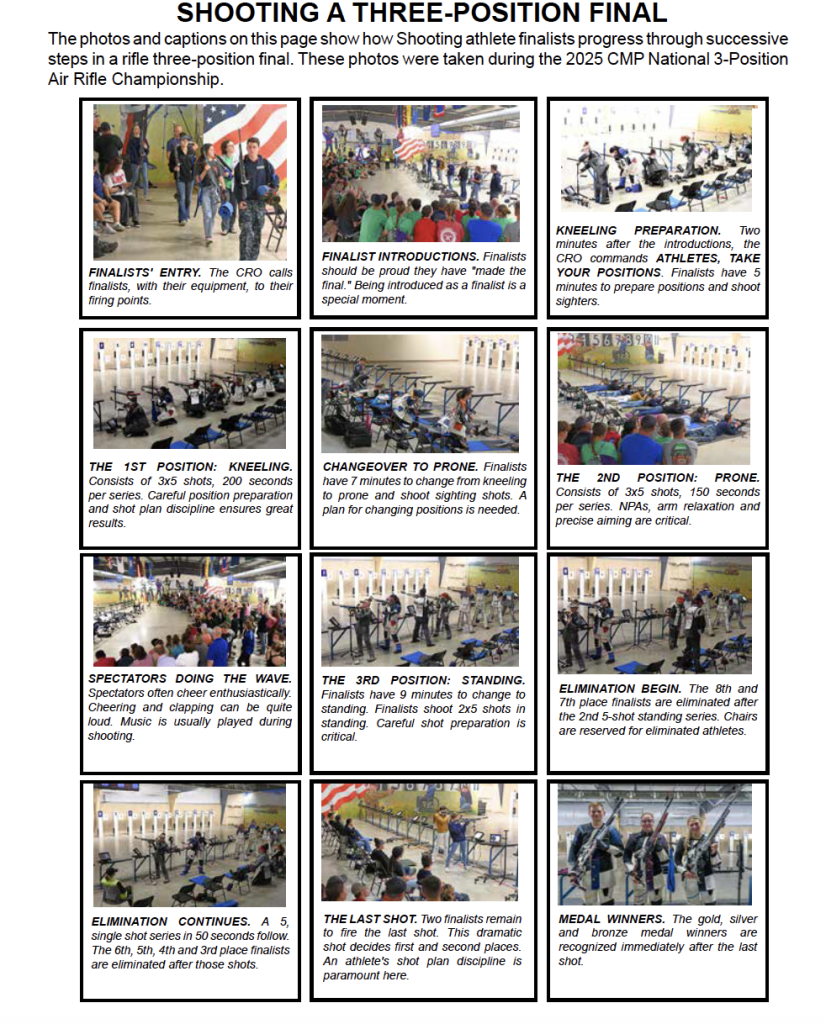BECOMING A SUCCESSFUL FINALS COMPETITOR
October 24, 2025
Civilian Marksmanship Program▸The First Shot▸BECOMING A SUCCESSFUL FINALS COMPETITORBy Gary Anderson, DCM Emeritus
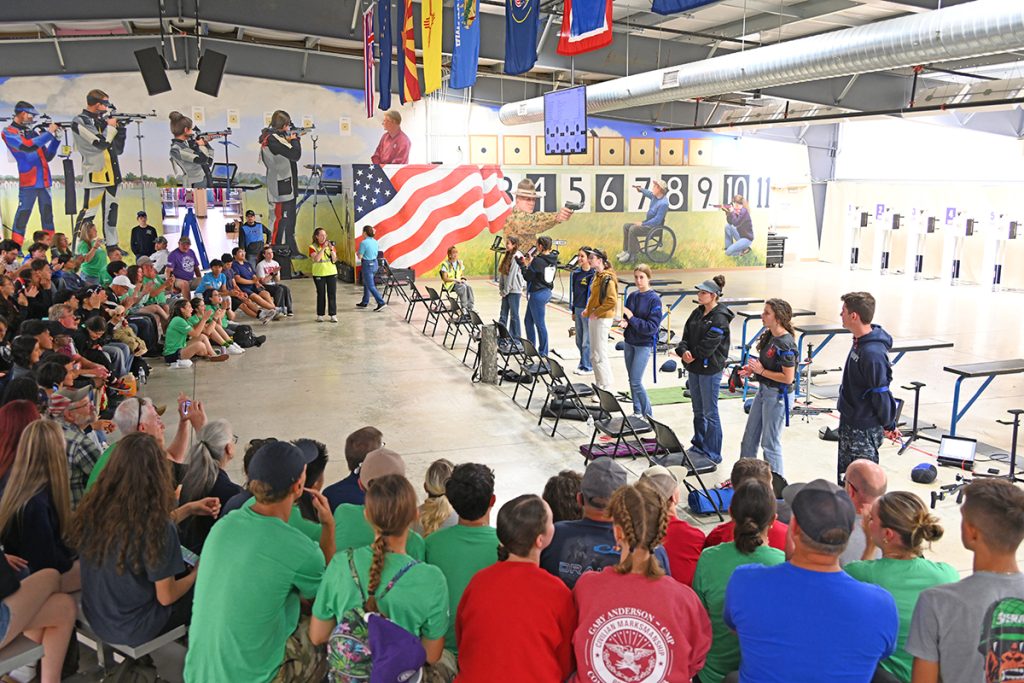
Finals that decide individual Shooting events are now a vital part of our sport. Most significant competitions that junior rifle and pistol athletes now attend include finals. This means many dedicated junior athletes who are advancing as position rifle or pistol competitors will find themselves qualifying for their first finals and, for most of them, more finals after that. This article is dedicated to those rising athletes. Its objective is to make sure that when you shoot your first finals you will be prepared to be a “successful finals competitor.”
The previous On the Mark (Summer 2025) featured an article titled “How to Conduct a Final.” That article was written for coaches and match officials. It noted how finals for the top eight competitors in competitions, which were once an exclusive feature of international and national championships, are now part of most major junior smallbore or air gun rifle or pistol competitions. That article pointed out how electronic targets are a practical necessity for conducting finals. It provided the good news that the number of ranges in the USA with eight or more electronic targets and can host a final is now encouragingly large. The Scopos1 firm reports that there are already about 175 indoor ranges in the USA with eight or more Athena electronic targets. That together with targets installed by other manufacturers means there are about 200 10m ranges in the USA that offer the possibility of hosting finals for indoor Junior rifle and pistol competitions. The availability of so many air gun ranges with electronic targets also makes it possible to shoot practice finals during training or even as fun competitions among team members.
Most of these ranges also have LCD panels or projection systems attached to the computer that controls targets. The display system should make it possible for spectators, to watch finals. Results display software supplied with electronic target installations allows them to display finalist names, shots, scores and status (The illustration on the following page shows what spectators would see during a final conducted with Orion software).
FINALS BASICS
There are some things you should know before you shoot your first final. The main reason we have finals is to make Shooting an attractive spectator sport. Finals were developed by the International Shooting Sport Federation (ISSF, https://www.issf-sports.org/) in the 1980s. Since then, they have been used to decide all Olympic and most World Championship individual medals. In recent Olympic Games, Shooting has become one of the most popular TV and Internet sports. Finals are making Shooting a respected spectator sport.
TYPES OF FINALS. Every Olympic Shooting event and certain events derived from Olympic events like Three-Position Air Rifle have finals. The precise rules for finals vary according to the event. There are two types of finals that are commonly used in events where Junior rifle or pistol athletes compete. Single-position finals are used for precision pistol events as well as for air rifle 60-shots standing. Three-position finals decide three-position rifle events, including Junior Three-Position Air Rifle competitions. Single position finals incorporate 24 shots and take about 30 minutes while three-position finals have 45 shots and last about 50 minutes.2
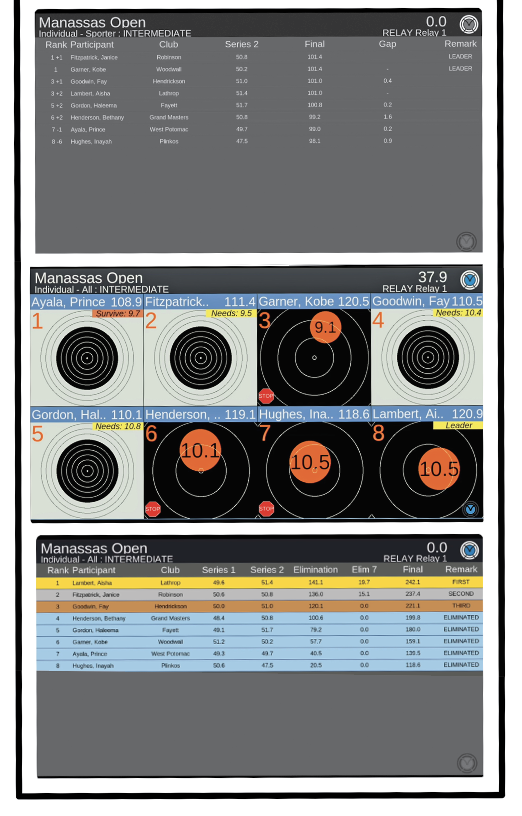
Finals are helping to make Shooting a spectator sport. During finals, spectators can see detailed results by watching results displays showing finalists’ shots, scores and rankings. The panels in this illustration show examples of what spectators will see during a Scopos Orion finals display. You can download a 9-minute video showing an entire mock final at https://youtu.be/sQryT9MvU1k?si=m70L143Q53m-_TE3.
FINALS RANGE FEATURES. Finals in international competitions usually take place in dedicated finals ranges with lots of spectator seating. They are designed to be theaters where television productions take place. The ranges where juniors can expect to shoot finals will be regular 10-meter or 50-foot ranges that are temporarily set up to conduct finals. Eight firing points are designated as finals firing points by using the letters A through H. Chairs are placed behind each final point where coaches can sit and where eliminated finalists can take their seats. There will be a table or Range Officer stand where the Target Technical Officer, Chief Range Officer and Announcer sit. Whenever possible, seating for spectators is provided. If the range has a display panel, it should be placed so spectators can see it.
WHO CONDUCTS FINALS. One Range Officer, functioning as a combined CRO (Chief Range Officer) and Announcer can conduct practice or fun-oriented finals. In competitions, there are normally a CRO, an Announcer and a Technical Officer. The CRO conducts the final and gives range commands, the Announcer provides commentary for spectators and the Technical Officer operates the targets and results systems.
FINALS COMPETITION STRUCTURE. A first step in preparing to shoot a final is to learn the basic rules that govern how they are conducted. The charts on page 9 list the step-by-step actions that occur during the two types of finals. Finals begin with athlete introductions that are followed by a preparation & sighting time. Record firing of 5-shot series follows. After each record series or shot the CRO commands STOP, and the Announcer gives brief commentary about who is leading and the scores just fired. Finals end with single shots, after which the lowest ranking athletes are eliminated. Finals end with the two leading athletes firing a last single shot to decide the gold and silver medal winners.
Clubs or teams that do not yet have electronic targets or that have fewer than eight electronic targets can still practice finals stages like 5-shot series or single shots as well as position changeovers.
CHALLENGES PRESENTED BY FINALS
There are several aspects of finals that make them supreme tests of Shooting athletes’ skills while simultaneously making them appealing to spectators and television viewers. Here are some things you should know about finals:
Reporting Time. Finals in large competitions usually require finalists to report to an assembly point 20 to 30 minutes before the final starts. A Match Official will use this time to brief finalists. If you qualify for a final that has a specific reporting time or place, don’t miss it, and don’t be late.
Short Firing Times. The firing times allowed in finals are based on 40 sec. per shot kneeling, 30 sec. per shot prone and 50 sec. per shot standing. Five-shot series firing times are 200 sec. for kneeling, 150 sec. for prone and 250 sec. for standing. Taking repeated holds to fire a shot is not possible with such short firing times. To adapt to these short time limits, finalists must become skilled at preparing firing positions that produce consistent good holds on first attempts.
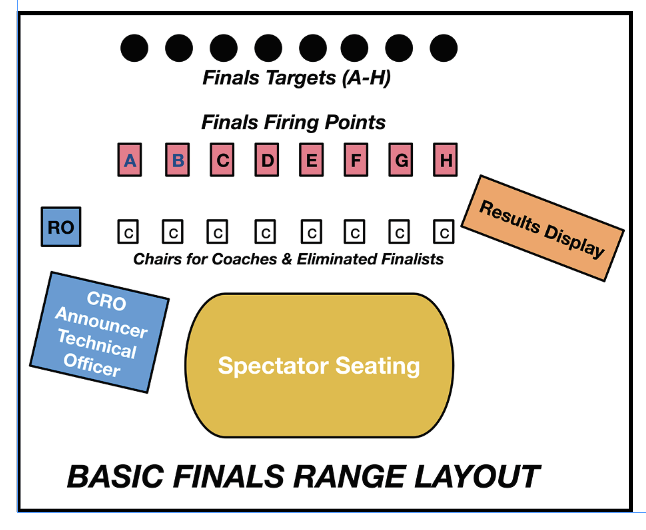
Spectators. Finals are designed for spectators, whether they are in the range, on the Internet or watching on television. Spectators on the range are encouraged to applaud and cheer during record firing and Announcer commentary. Spectators do this in every other youth sport, why not also in Shooting? In Junior competitions in Europe, it is not uncommon for crowd noise to reach 100 decibels or more. Successful finalists get pretty good at just zoning out spectator acclamations.
Announcer Commentary. In finals, the Announcer and scoreboard display tell spectators all about your scores. In fact, the more often you hear the Announcer say your name the more likely it is that you are doing well. Learn to enjoy hearing your name, especially when it means you have fired a great series or shot.
Quick Position Changes. Three-position finals add the unique challenge of needing to adjust equipment, set up stable firing positions and fire meaningful sighters in short periods of time. Finalists have five minutes to finish kneeling preparation, seven minutes to switch to prone and fire sighters and nine minutes to switch to standing. Three-position finalists, especially in the precision category, need carefully thought-out position change plans that dictate what they do with sights, cheek-pieces and butt-plates, any clothing adjustments and precise steps to then set up stable firing positions.
How to Handle Problems. Athletes hope they can get through finals without encountering any problems, but the wise athlete also goes into finals with a mental plan for how they will deal with the unexpected. That could be a target failure, a distraction from someone in the crowd, a rifle or pistol malfunction or something totally unexpected. The key is to stay calm. Raise your hand to get the Range Officer’s attention and report your problem. If it’s a target malfunction, you may have to move to another firing point. If you have a gun malfunction, you only have a minute to get it resolved or replace your gun. If you encounter a problem, stay calm and try to work with the RO to resolve it.
FINALS TIPS FOR RISING JUNIORS
For rising Junior athletes who look forward to making their first finals, here are some specific tips and instructions about things you can do to prepare:
1. Learn About Finals. When you shoot in matches, attend them even if you or your teammates are not in them. Pay attention to how the final is conducted. Try to imagine how you would respond if you were in that final. See yourself staying calm, while performing well. Another great way to learn about how the world’s best rifle and pistol athletes perform in finals is to watch the ISSF-TV productions that are posted on YouTube™ at https://www.youtube.com/issfchannel.
2. Know Finals Rules. Most key finals rules are incorporated into the bullet point charts to the right. Master the procedures in the appropriate chart. A couple of key rules are worth noting a) Do not load until the LOAD command is given (loading includes placing a cartridge or pellet in contact with the rifle or pistol) and b) In three-position finals, don’t start changeovers until the CRO announces them and gives the START command. Note: If you are a pistol athlete, the 10m Air Pistol Final is essentially the same as a Single Position Final. The 25m Pistol Final consists of a succession of 5-shot rapid-fire series (pistol down 7 seconds, up 3 seconds for each shot).
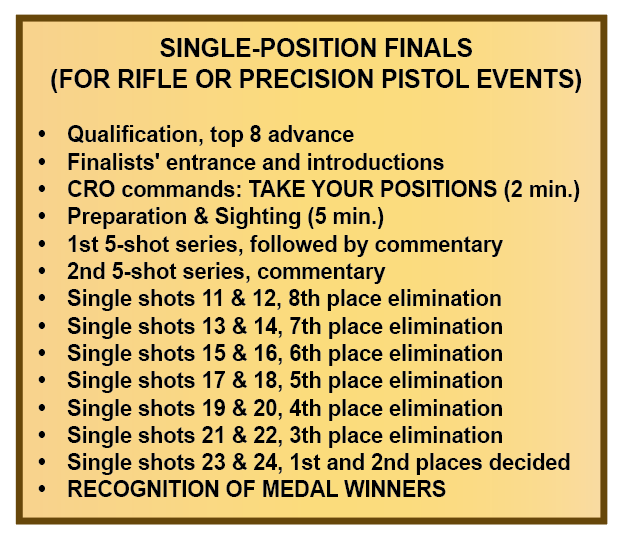
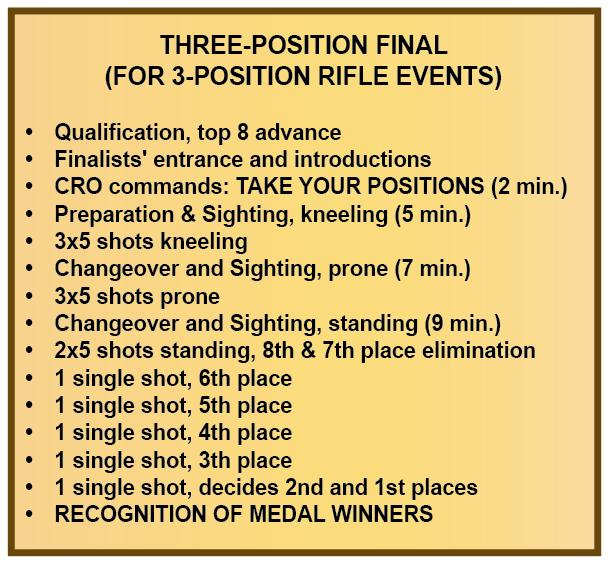
3. Practice Finals. One of the best ways to prepare for finals is to shoot practice finals at your home range. Besides helping you understand the sequence and timing of a final, practice finals can be a lot of fun. Trying to be the last athlete standing is a good way to temper athletes’ nerves for the stresses that come from competitions and competition finals. If your range doesn’t have electronic targets, you can still practice important aspects of finals such as firing with short time limits and position changeovers.
4. Expect to Enjoy Your Finals Experience. How well the final goes for a young athlete depends a lot on their expectations. If they let fear of a poor performance overcome their thoughts, that becomes a likely result. Conversely, the athlete who learns about finals and prepares for them can look forward to their finals experience with anticipation. Certainly, there is more pressure and heightened anxiety in a final, but experiencing nervousness can be a good feeling. Nervousness sharpens your senses to everything occurring around you, so if you have a shot plan and the self-discipline to follow it, even during times of greater pressure, a good performance is a likely result.
5. Finalist Introductions. Finalist introductions at the beginning of each final are a way to recognize the athletes who qualify and give brief information about them to spectators. Your introduction is a chance for you to give spectators a reason to like you. A warm smile and an enthusiastic wave do that well.
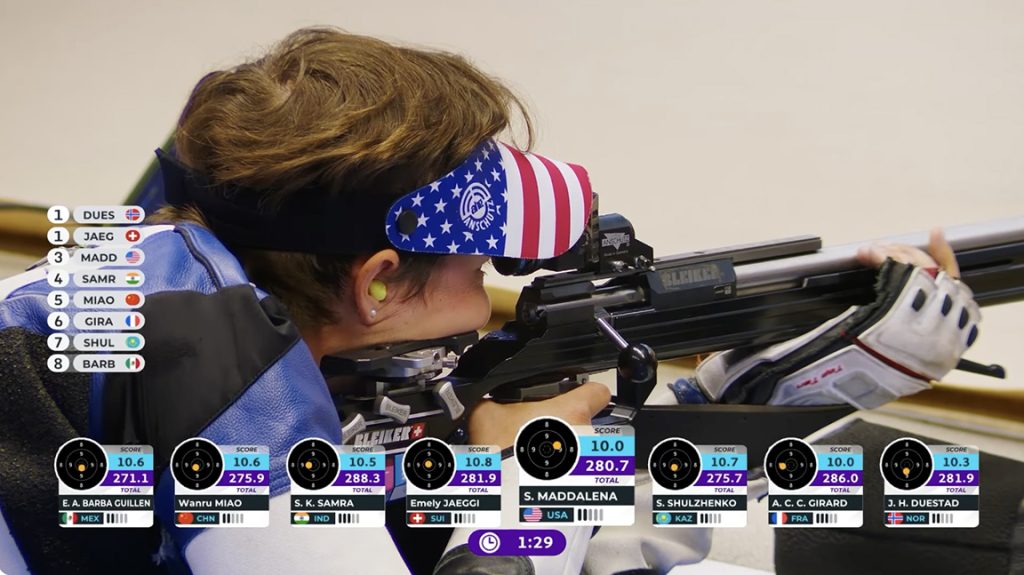
6. Position Preparation. Before finals were introduced in the 1980s and 1990s, the best shooters were trained to reject unsatisfactory holds even if it took three or four holds to fire a good shot. Finals rules don’t allow enough time for that. Successful finals athletes must be able to consistently fire good shots on their first holds. The key to doing that is POSITION PREPARATION. Consistently good first holds are produced by devoting a few extra seconds to position preparation before starting to aim. Those steps include a) relaxing the support arm, b) relaxing the body and c) balancing the position. For succeeding shots, most finals athletes now save time by keeping their rifle in their shoulder to load. A successful alternative in standing is to rest the rifle on a rifle stand and to load and shoulder the rifle or pistol when the LOAD command is given. There is a 5 sec. pause after LOAD; use it to start position preparation. The rules do permit finalists to do aiming or holding exercises during the time between record series or shots. Many finalists use those repetitions to help stabilize their positions.
7. Firing the Shot. Once aiming begins, the completion of the shot plan can proceed. Centering sight picture movements is followed by adding pressure to the trigger to release the shot. This should be the culmination of a shot plan that has been practiced myriad times. A final is definitely not the time to do something new or different. If the shot was good, give yourself a mental reward and then focus your thoughts on something relaxing during Announcer commentary and waiting for the next commands.
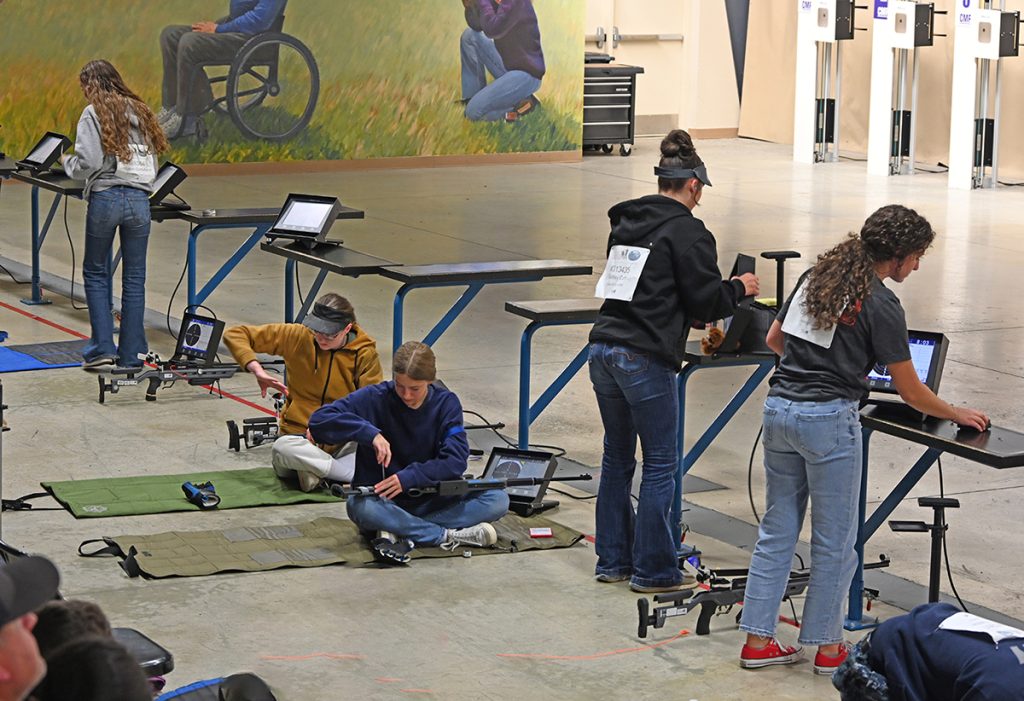
8. Be Prepared for Spectators, Cheering and Noise. Spectators at the range and Internet viewers on electronic devices are important to Shooting. Many regional and national competition finals now attract hundreds of spectators. Olympic Shooting Finals, in fact, will have thousands of spectators and millions of Internet/TV viewers. Expect crowd noise in your finals too. Wearing hearing protection may reduce the volume somewhat but it’s not going to go away. Identify things to think about that will help you ignore the crowd noise and get mentally prepared for your next series or shot.
9. The Announcer is Going to Call Your Name. After each 5-shot series and succeeding single shots, the CRO will command STOP, and the Announcer will make brief comments about who is leading and who is advancing and falling back. Be prepared for the Announcer to call your name, especially if you are in the top three or four places. Have something to think about during these interludes, so you won’t pay too much attention to what is being said. Your mind should be on what the CRO will soon command: FOR YOUR NEXT COMPETITION SERIES/SHOT…LOAD.
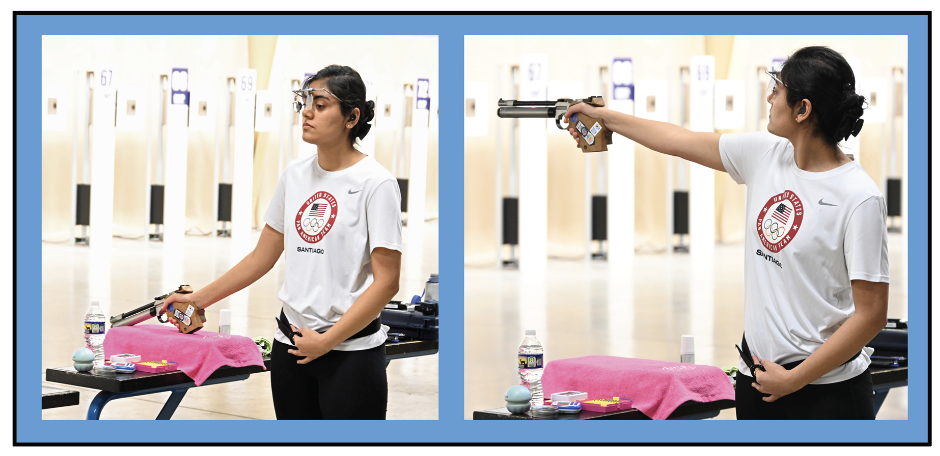
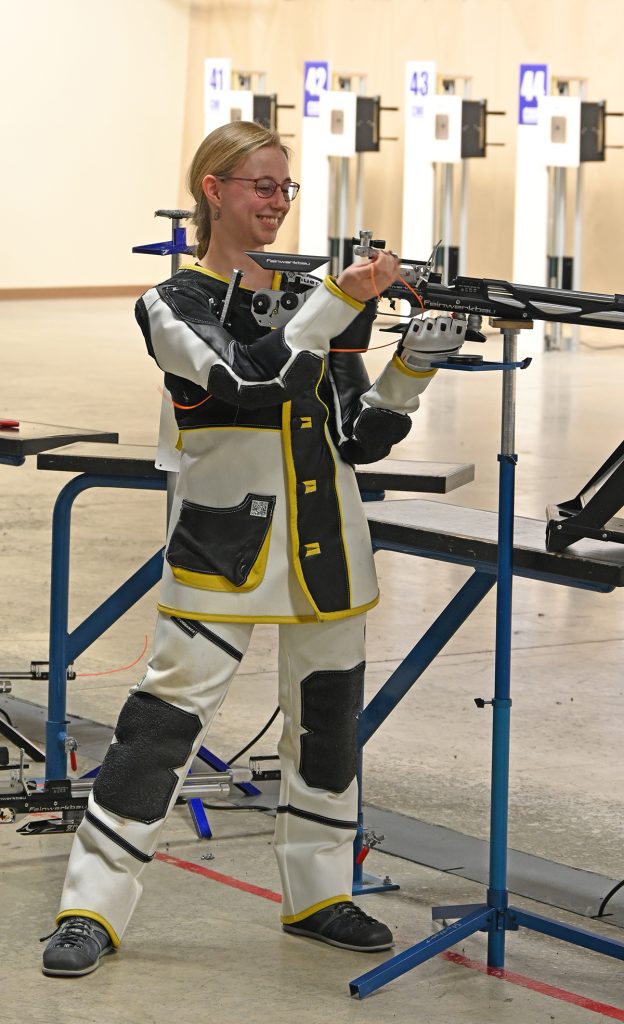
10. If You Get to Make The Last Shot. The two athletes who make the last shot in a final have already proven themselves as the best in that final. They must remember that they have already made a series of good shots to get to that climax. The athlete who shoots great last shots is an athlete who has a clear shot plan and who has the self-discipline to prepare and execute that shot the same way they executed many good shots that got them to this point.
Finals truly are a vital part of our sport today. Young rifle and pistol athletes who show promise of success in Shooting must learn about finals, be taught how to prepare for them and be afforded opportunities to practice them on their home ranges. If they are well prepared for the exciting times when their names will be announced as finalists at competitions, they will likely become “Successful Finals Competitors.”
- Scopos (www.scopos.tech) is the only USA manufacturer of electronic targets for 10m and 50 ft. rifle and pistol shooting. ↩︎
- The IOC and ISSF recently announced that starting in 2026, 50m Rifle Three-Position finals will be shot in one position only, standing. This decision likely will impact CMP and possibly Junior Three-Position Air Rifle finals rules in future years with the possibility that most finals will be single-position finals. ↩︎
